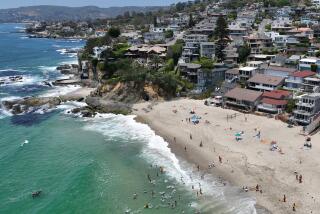Fish and Game Wardens Dig In to Catch Pismo Clam Poachers
- Share via
State Fish and Game Warden David Brown’s face lit up with a smile Saturday when he spotted the clam poachers at Oxnard Shores beach.
“There’s four of them out there,” he said shortly after sunrise, as he looked out of his binoculars from a distance. “You can see them digging up clams and throwing them into bags.”
On this gray, misty morning when the tide was low enough to expose a wide expanse of sandy beach, Brown, 38, would score the biggest clam bust of his four-year career. More than 1,000 clams were seized in less than an hour’s work--about a fourth of what Fish and Game’s five Ventura County clam cops recover in a whole year.
The Pismo clam, as the local variety is known, is found in beaches from San Luis Obispo to Baja California. In the past 30 years, their numbers have steadily dwindled because development has destroyed habitats and clam diggers have been relentless, Brown said.
Fish and Game has established a limit of 10 clams per person with a valid fishing license. Only clams bigger than 4 1/2 inches in diameter can be dug up--a rarity, to say the least. In Ventura County, five wardens patrol the beaches at low tide to enforce the restrictions.
Under state law, clam poachers can receive up to $2,000 in fines and six months in jail, but Brown said that has never happened. Instead, Ventura judges normally waive jail time and impose fines of $70 to $250.
“Good morning,” said Brown, announcing himself to the stunned poachers after sneaking up on them from behind a sand dune. A Vietnamese man and his young son were caught with their ankles buried in the sand, twisting their feet in a clam-searching technique know as “the shuffle.” A young man and a woman, also Vietnamese, were squatting nearby, unloading clams from aluminum drainers into two white plastic bags.
“Looks like we have a lot of Pismo clams,” Brown said sarcastically, sinking his hand into one of the loaded bags. The biggest clam was about two inches long.
The child’s father, Sau Truang, 53, replied, “I no speak English.” The woman, Truang’s niece, Dung Nueng, started to cry. The young man, 21-year-old Quag Tse Diep, stepped back and started practicing gymnastics. He would later claim that he had nothing to do with the clams.
Minh Truang, 11, told Brown on behalf of the family that “we were just swimming around, and we felt something funny under our feet, so we decided to pick them up,” he said. “This is our first time. We didn’t know it was illegal.”
Brown was unimpressed. After counting and measuring the clams, he pulled out his citation pad and began writing.
“A ticket? Oh no!” Nueng cried. “This first time here and no more. I’m sorry! I’m sorry!”
“Well, they all are,” Brown coolly replied without looking up, as he kept on writing. “Next time, you’ll know.”
Minh Truang said his family lived on welfare since arriving from Vietnam 14 years ago. Before that, the boy said, his father caught fish every morning and then sold it in the streets of Saigon.
After signing their tickets, the Truangs left. The clams were released back into the rising tide with the help of two female beach joggers who had witnessed the bust. The women were grateful to Brown and critical of the Truangs.
“It’s like rape, pillage and plunder,” Gail Sloan, 35, said indignantly. She told Brown that she saw the same Truang family members two days ago with six bags full of clams. “What do they need all those clams for?” she said.
“Yeah, hit them in the pocketbook, where it hurts the most,” added Sally Cudworth, 52. She said she had just learned from Brown that excess clam digging was illegal.
More to Read
Sign up for Essential California
The most important California stories and recommendations in your inbox every morning.
You may occasionally receive promotional content from the Los Angeles Times.










